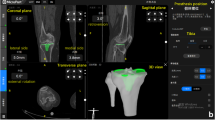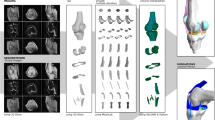Abstract
The characterization of ligamentous soft tissue properties is limited by a lack of measurement methods capable of minimally-invasively quantifying regional strain. Previous implementations of radiographic imaging and tissue-embedded radiopaque markers demonstrated promising regional strain measurements, but found error associated with non-repeatable bead positions within the tissue after load application. No study has investigated the effects of cyclic loading on the strains measured within the tissue. The purpose of this study was to quantify the effect of joint loading on strain measurement using radiopaque markers and micro-computed tomography imaging. Six cadaveric porcine femur-anterior cruciate ligament-tibia complexes were instrumented with small diameter (0.8 mm) zirconium dioxide marker beads. The compound was imaged at 10 N then at 100 N of anterior force using micro-computed tomography. The bead positions in the images were used to calculate tissue strain between the 10 and 100 N anterior joint load conditions. Up to 100 intermediate joint cycles were applied, then images were acquired again at 10 and 100 N anterior force. No statistically significant difference was found between the strains measured before and after intermediate cycling (p > 0.05). This indicates that tissue loading did not introduce statistically significant changes to strains measured in tissue tested following this methodology.





Similar content being viewed by others
References
Andriacchi, T. P., A. Mundermann, R. L. Smith, E. J. Alexander, C. O. Dyrby, and S. Koo. A framework for the in vivo pathomechanics of osteoarthritis at the knee. Ann. Biomed. Eng. 32:447–457, 2004.
Beaulieu, M. L., J. A. Haladik, M. J. Bey, and S. G. McLean. Validation of a novel method for quantifying and comparing regional ACL elongations during uniaxial tensile loading. J. Biomech. 45:2710–2714, 2012.
Berns, G. S., M. L. Hull, and H. A. Patterson. Strain in the anteromedial bundle of the anterior cruciate ligament under combined loading conditions. J. Orthop. Res. 10:167–176, 1992.
Bey, M. J., S. K. Kline, A. R. Baker, J. A. McCarron, J. P. Iannotti, and K. A. Derwin. Estimation of dynamic, in vivo soft-tissue deformation: experimental technique and application in a canine model of tendon injury and repair. J. Orthop. Res. 29:822–827, 2011.
Beynnon, B. D., R. J. Johnson, B. C. Fleming, C. J. Stankewich, P. A. Renström, and C. E. Nichols. The strain behavior of the anterior cruciate ligament during squatting and active flexion-extension. Am. J. Sports Med. 25:823–829, 1997.
Beynnon, D. B., and B. C. Fleming. Anterior cruciate ligament strain in-vivo : a review of previous work. J. Biomech. 31:519–525, 1998.
Blokker, A., T. Burkhart, D. Holdsworth, and A. Getgood. Soft tissue strain measurement in human cadaveric knees using embedded radiopaque markers, 2018.
Blokker, A., A. Getgood, N. Curiale, H. Nikolov, J. Laing, D. W. Holdsworth, and T. Burkhart. Development and assessment of a microcomputed tomogrpahy compatible five degrees-of-freedom knee joint motion simulator. J. Biomech. Eng. 141:1–10, 2019.
Chandrashekar, N., H. Mansouri, J. Slauterbeck, and J. Hashemi. Sex-based differences in the tensile properties of the human anterior cruciate ligament. J. Biomech. 39:2943–2950, 2006.
Driban, J. B., C. B. Eaton, G. H. Lo, R. J. Ward, B. Lu, and T. E. McAlindon. Association of knee injuries with accelerated knee osteoarthritis progression: data from the osteoarthritis initiative. Arthritis Care Res. 66:1673–1679, 2014.
Duquette, A., and D. M. Andrews. Comparing methods of quantifying tibial acceleration slope comparing methods of quantifying tibial acceleration slope. J. Appl. Biomech. 26:229–233, 2010.
Howell, D. C. The treatment of missing data. In: The SAGE Handbook of Social Science Methodology, edited by W. Outhwaite, and S. Turner. London, UK: Sage, 2008, pp. 208–224. https://doi.org/10.1007/978-1-4614-4018-5.
Imhauser, C., C. Mauro, D. Choi, E. Rosenberg, S. Mathew, J. Nguyen, Y. Ma, and T. Wickiewicz. Abnormal tibiofemoral contact stress and its association with altered kinematics after center-center anterior cruciate ligament reconstruction: an in vitro study. Am. J. Sports Med. 41:815–825, 2013.
Jung, H., G. Vangipuram, M. B. Fisher, G. Yang, S. Hsu, J. Bianchi, and C. Ronholdt. The effects of multiple freeze—thaw cycles on the biomechanical properties of the human bone-patellar tendon-bone allograft. J. Orthop. Res. 29:1193–1198, 2011. https://doi.org/10.1002/jor.21373.
Khan, R., A. Konyves, K. R. B. S. Rama, R. Thomas, and A. A. Amis. RSA can measure ACL graft stretching and migration. Clin. Orthop. Relat. Res. 448:139–145, 2006.
Kolaczek, S., C. Hewison, S. Caterine, M. X. Ragbar, A. Getgood, and K. D. Gordon. Analysis of 3D strain in the human medial meniscus. J. Mech. Behav. Biomed. Mater. 63:470–475, 2016.
Livesay, G. A., H. Fujie, S. Kashiwaguchi, D. A. Morrow, F. H. Fu, and S. L. Woo. Determination of the in situ forces and force distribution within the human anterior cruciate ligament. Ann. Biomed. Eng. 23:467–474, 1995.
Loh, J. C., Y. Fukuda, E. Tsuda, R. J. Steadman, F. H. Fu, and S. L. Y. Woo. Knee stability and graft function following anterior cruciate ligament reconstruction: comparison between 11 o’clock and 10 o’clock femoral tunnel placement. Arthrosc. J. Arthrosc. Relat. Surg. 19:297–304, 2003.
Luque-Seron, J. A., and I. Medina-Porqueres. Anterior cruciate ligament strain in vivo: a systematic review. Sports Health 8:451–455, 2016.
McLean, S. G., K. F. Mallett, and E. M. Arruda. Deconstructing the anterior cruciate ligament: what we know and do not know about function, material properties, and injury mechanics. J. Biomech. Eng. 137:020906, 2015.
Roos, P. J., M. L. Hull, and S. M. Howell. How cyclic loading affects the migration of radio-opaque markers attached to tendon grafts using a new method: a study using roentgen stereophotogrammetric analysis (RSA). J. Biomech. Eng. 126:62–69, 2004.
Spencer, L., T. A. Burkhart, M. N. Tran, A. J. Rezansoff, S. Deo, S. Caterine, and A. M. Getgood. Biomechanical analysis of simulated clinical testing and reconstruction of the anterolateral ligament of the knee. Am. J. Sports Med. 43:2189–2197, 2015.
Waldman, L. K., Y. C. Fung, and J. W. Covell. Transmural myocardial deformation in the canine left ventricle: normal in vivo three-dimensional finite strains. Circ. Res. 57:152–163, 1985.
Woo, S., J. M. Hollis, D. J. Adams, R. M. Lyon, and S. Takai. Tensile properties of the human femur- anterior cruciate ligament-tibia complex The effects of. Am. J. Sports Med. 19:217–225, 1991.
Acknowledgments
The authors would like to thank the Mount Brydges Abattoir for their generous donation of all porcine specimens. They would also like to thank Jaques Milner for the centroiding software development, as well as Ivailo Petrov and Steven Pollmann for assistance with image analysis. Finally, the authors would like to acknowledge Smith and Nephew Inc. (A17-ASDUS-GR-598), the CIHR (Canadian Research Leaders in Musculoskeletal Health, PCS 150478) (Dynamic Imaging of Musculoskeletal Systems, FDN148474), the Ontario Research Fund (Research Excellence), ConMed Linvatec Inc (Canada Research Grant), and the Western Bone and Joint Institute for financial assistance.
Author information
Authors and Affiliations
Corresponding author
Additional information
Associate Editor Peter E. McHugh oversaw the review of this article.
Publisher's Note
Springer Nature remains neutral with regard to jurisdictional claims in published maps and institutional affiliations.
Rights and permissions
About this article
Cite this article
Blokker, A.M., Getgood, A., Nguyen, D. et al. Insertion of Small Diameter Radiopaque Tracking Beads into the Anterior Cruciate Ligament Results in Repeatable Strain Measurement Without Affecting the Material Properties. Ann Biomed Eng 49, 98–105 (2021). https://doi.org/10.1007/s10439-020-02511-2
Received:
Accepted:
Published:
Issue Date:
DOI: https://doi.org/10.1007/s10439-020-02511-2




